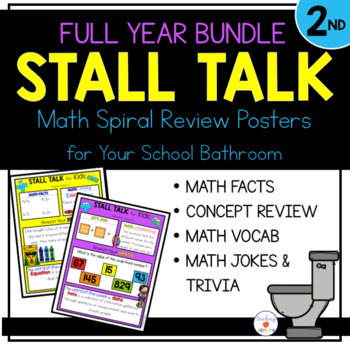2nd Grade Spiral Review Posters- Full Year Stall Talk Bundle
- Zip
Products in this Bundle (12)
showing 1-5 of 12 products
Description
This bundle includes all 2nd Grade Stall Talk Posters. Stall Talk is a fun set of spiral review posters for you to hang in your school bathrooms. Think about how much time your students are spending in the bathroom! Use that time wisely!
This is a bundle, which means that each individual resource for 2nd grade is included in your purchase. There are 11 individual files included in the bundle. The bundle is discounted by 25%.
Each week includes basic fact/skill practice, a more advanced skill, a math joke, math trick or interesting bit of math trivia, and a vocabulary word +example. The content follows a scope and sequence for 2nd grade and include Common Core Math Vocabulary.
If you have any questions, please send me a message! All of my individual 2nd Grade Stall Talk files can be found here.





